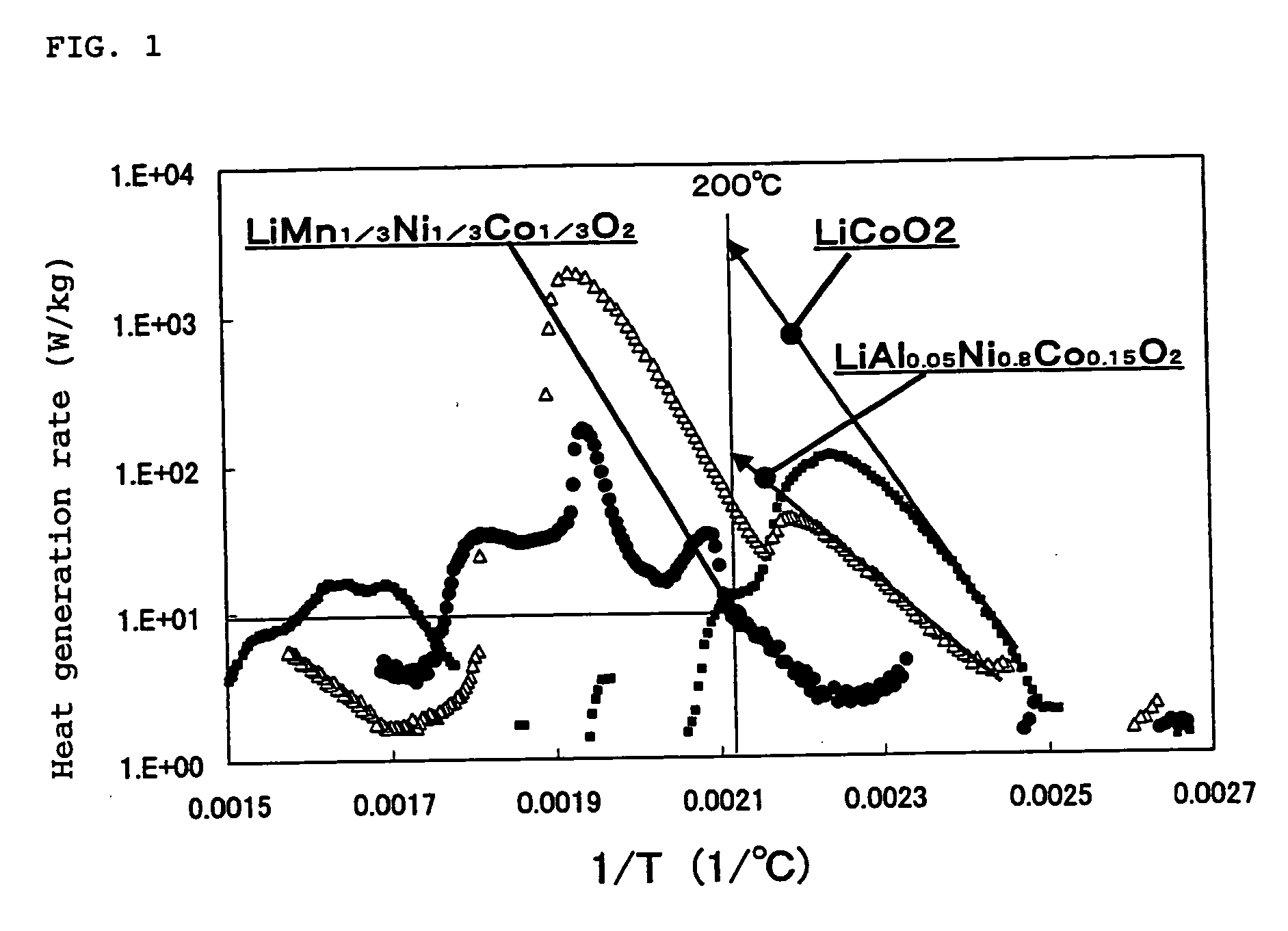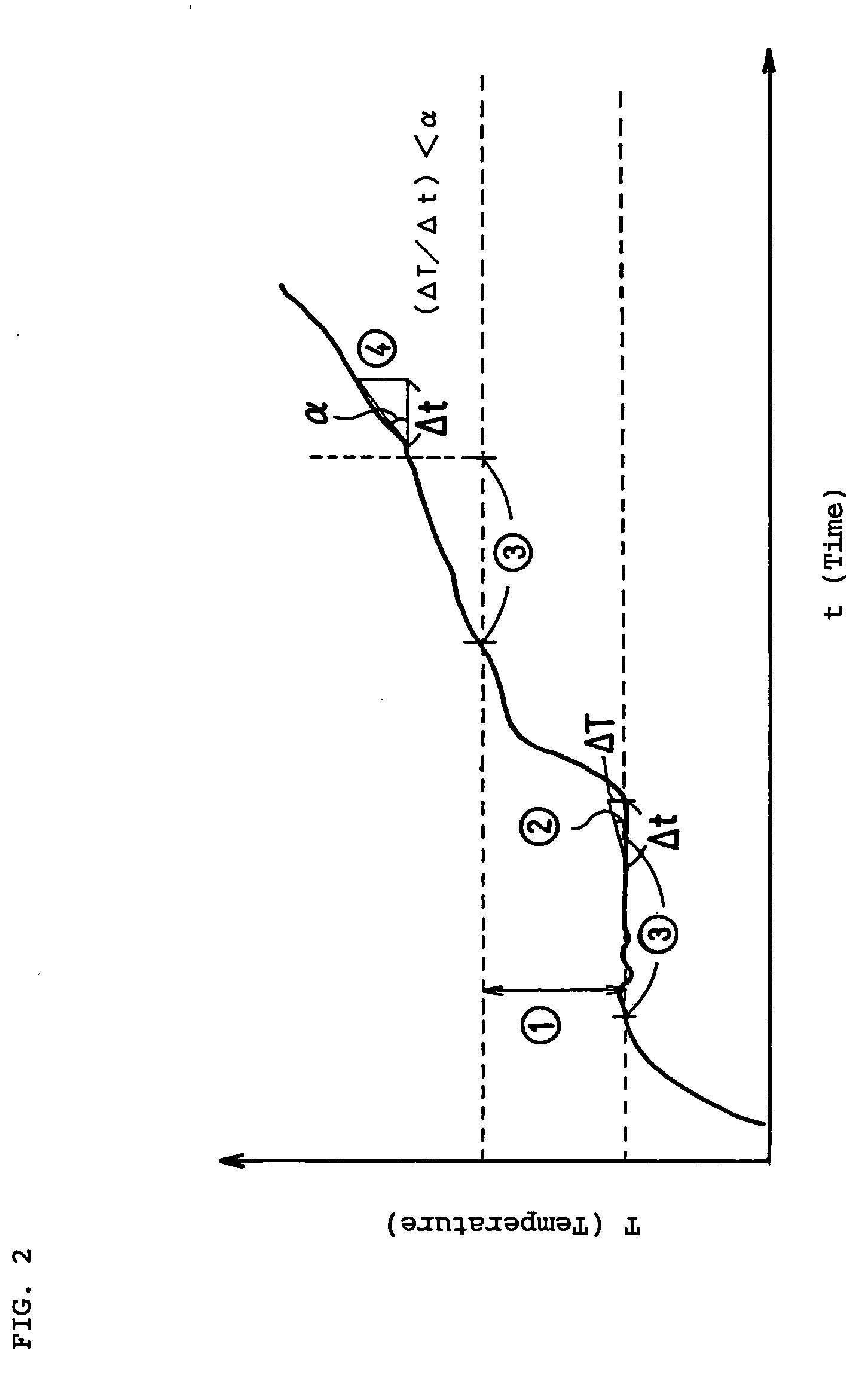Non-aqueous electrolyte secondary battery
a secondary battery and electrolyte technology, applied in the field of non-aqueous electrolyte secondary batteries, can solve the problems of excessive heat of the battery, excessive temperature of the battery, deformation of the body of the electronic device, etc., and achieve the effect of high energy density and high safety level
- Summary
- Abstract
- Description
- Claims
- Application Information
AI Technical Summary
Benefits of technology
Problems solved by technology
Method used
Image
Examples
experiment 1
Measurement of Temperature of Shorted Point
[0068] Ten different 18650 type cylindrical non-aqueous electrolyte secondary batteries each having a diameter of 18 mm and a height of 65 mm were produced. For the production, lithium cobalt oxide (LiCoO2) was used as the positive electrode active material. A heat-resistant insulating layer comprising an inorganic oxide filler and a resin component was formed on the negative electrode surface. The produced batteries were subjected to nail penetration test to check the temperature increase of a shorted point 0.5 second after the penetration of a nail.
[0069] In this experiment, a thermocouple was attached to the surface of each battery. A nail was penetrated near the thermocouple, and the surface temperature of the battery was measured. The results are shown in Table 1.
TABLE 1Temperature of shorted pointBattery(° C.)Cylindrical battery 1205Cylindrical battery 2203Cylindrical battery 3201Cylindrical battery 4205Cylindrical battery 5216Cy...
experiment 2
Investigation of Positive Electrode Active Material
[0084] Because it has been shown that the heat-resistant insulating layer and the thermal stability of the positive electrode active material are two very important factors, an investigation was conducted on the thermal stability of the positive electrode material mixture. In this experiment, the estimated heat generation rate at 200° C. of positive electrode material mixtures containing positive electrode materials 1 to 3 listed in Table 2 were measured.
TABLE 2Positive electrode material 1LiMn1 / 3Ni1 / 3Co1 / 3O2Positive electrode material 2LiAl0.05Ni0.8Co0.15O2Positive electrode material 3LiCoO2
[0085] Using the materials 1 to 3 listed in Table 2 as the positive electrode active material, three different 18650 type cylindrical non-aqueous electrolyte secondary batteries were produced in the same manner as in EXPERIMENT 1. The produced batteries (hereinafter referred to as batteries 1A to 3A) were charged under the following conditio...
examples 25 to 35
[0129] Eleven different 18650 type cylindrical non-aqueous electrolyte secondary batteries (hereinafter referred to as batteries of EXAMPLEs 25 to 35) were produced in the same manner as in EXPERIMENT 1 except that the positive electrode materials 14 to 24 (composite lithium oxides having a composition of LiCo0.98M0.02O2) listed in Table 8 were used, and that a heat-resistant insulating layer comprising aramid resin and an inorganic oxide filler was formed on a separator such that the dried layer had a thickness of 5 μm as in EXAMPLE 6. In the same manner as in EXPERIMENT 2, the estimated heat generation rate at 200° C. of the positive electrode material mixture was determined. Further, the batteries of EXAMPLEs 25 to 35, ten of each, were subjected to the nail penetration test, and the average of the maximum battery surface temperature of ten batteries was calculated. The results are shown in Table 8.
TABLE 8EstimatedheatMaximumgenerationbattery surfaceCompositionLiCo0.98M0.02O2ra...
PUM
| Property | Measurement | Unit |
|---|---|---|
| thickness | aaaaa | aaaaa |
| surface temperature | aaaaa | aaaaa |
| thick | aaaaa | aaaaa |
Abstract
Description
Claims
Application Information
 Login to View More
Login to View More - R&D
- Intellectual Property
- Life Sciences
- Materials
- Tech Scout
- Unparalleled Data Quality
- Higher Quality Content
- 60% Fewer Hallucinations
Browse by: Latest US Patents, China's latest patents, Technical Efficacy Thesaurus, Application Domain, Technology Topic, Popular Technical Reports.
© 2025 PatSnap. All rights reserved.Legal|Privacy policy|Modern Slavery Act Transparency Statement|Sitemap|About US| Contact US: help@patsnap.com


